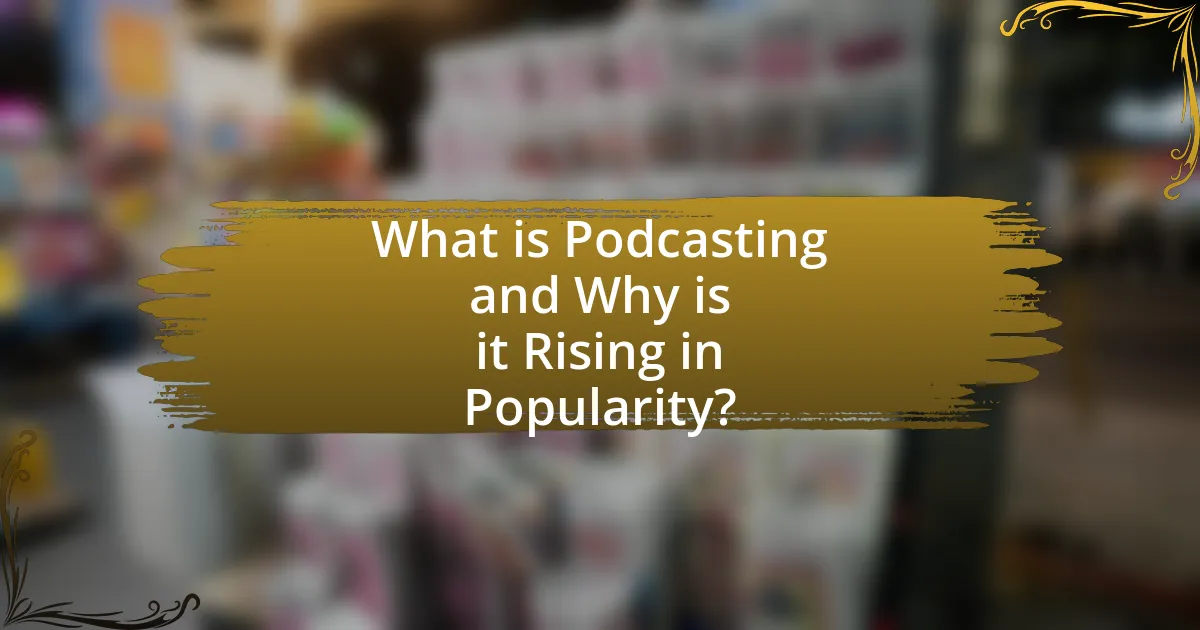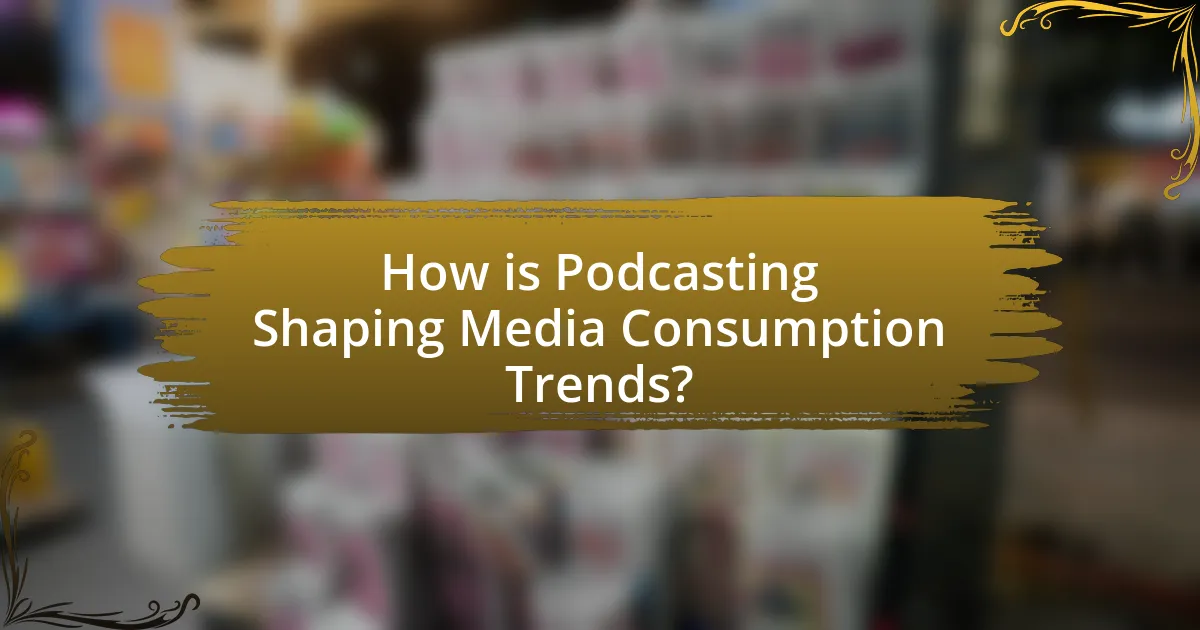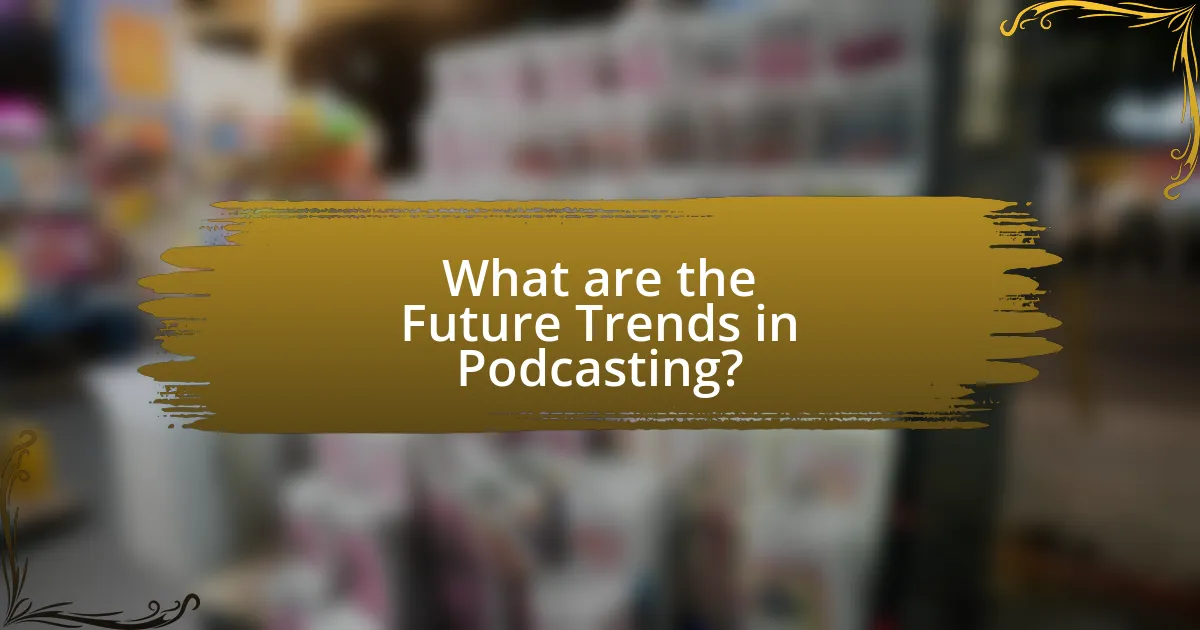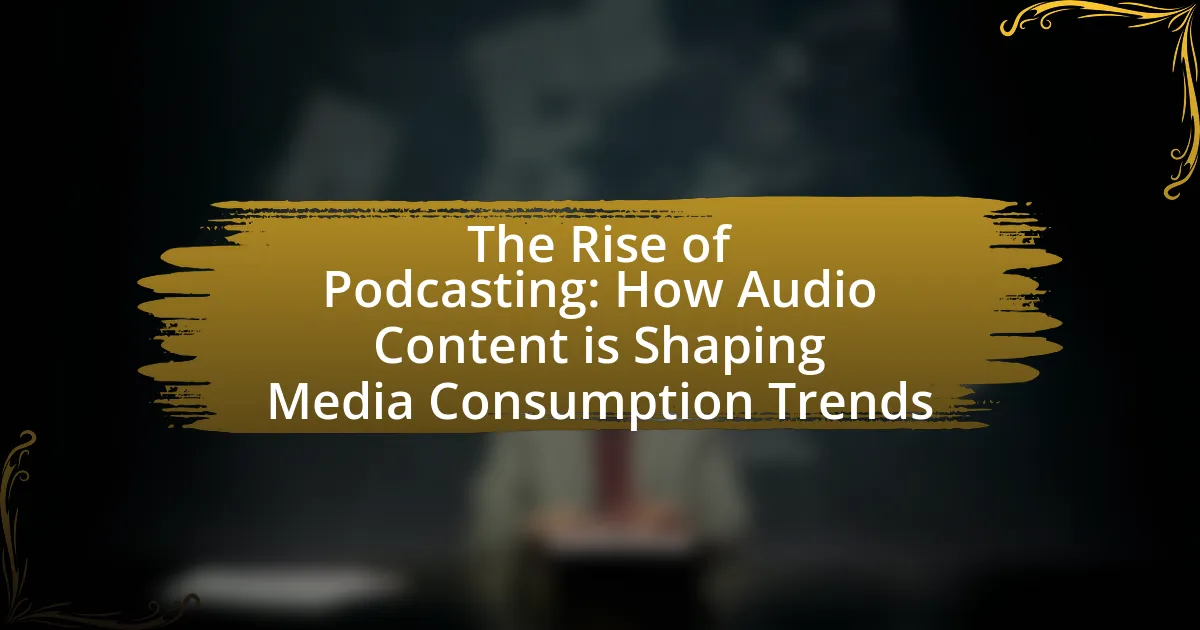Podcasting is a rapidly growing digital audio format that allows users to listen to episodes on various topics, with over 80 million Americans engaging with podcasts monthly as of 2023. The article explores the evolution of podcasting from a niche medium to a mainstream format, driven by technological advancements, cultural shifts, and changing consumer preferences. Key characteristics of successful podcasts, the impact of content quality and host charisma on listener engagement, and the advantages of audio content over traditional media are discussed. Additionally, the article examines demographic trends in podcast listenership, marketing strategies for brands, and the challenges faced by the podcasting industry, while also highlighting future trends such as personalization and the integration of artificial intelligence.

What is Podcasting and Why is it Rising in Popularity?
Podcasting is a digital audio format that allows users to listen to episodes on various topics, typically available for download or streaming. Its rising popularity can be attributed to several factors, including the increasing accessibility of smartphones and the internet, which has made it easier for audiences to consume content on-the-go. According to Edison Research, as of 2023, over 80 million Americans listen to podcasts monthly, reflecting a significant growth in audience engagement. Additionally, the diverse range of topics and the ability for creators to connect with niche audiences have contributed to its appeal, making podcasting a preferred medium for information and entertainment.
How has the definition of podcasting evolved over time?
The definition of podcasting has evolved from a niche form of audio content distribution to a mainstream media format. Initially, in the early 2000s, podcasting referred to downloadable audio files that users could listen to on portable media players, primarily focusing on amateur content. As technology advanced and platforms like Apple Podcasts and Spotify emerged, the definition expanded to include professionally produced shows, serialized storytelling, and diverse genres, reflecting a broader audience and increased production quality. By 2023, podcasting is recognized not only as a medium for entertainment but also as a vital tool for education, marketing, and news dissemination, with over 500 million podcasts available globally, indicating its significant impact on media consumption trends.
What technological advancements have contributed to podcasting’s growth?
Technological advancements such as the proliferation of smartphones, improved internet connectivity, and the development of user-friendly podcast hosting platforms have significantly contributed to podcasting’s growth. Smartphones have made it easier for users to access and listen to podcasts on-the-go, with over 3.5 billion smartphone users globally as of 2023. Enhanced internet speeds, particularly with the rollout of 4G and 5G networks, have facilitated seamless streaming and downloading of audio content. Additionally, platforms like Anchor and Libsyn have simplified the process of creating, distributing, and monetizing podcasts, enabling a diverse range of creators to enter the market. These advancements collectively have expanded the audience reach and accessibility of podcasts, driving their popularity.
How do cultural shifts influence the popularity of podcasting?
Cultural shifts significantly influence the popularity of podcasting by altering consumer preferences and media consumption habits. For instance, the rise of mobile technology and increased internet accessibility have led to a demand for on-the-go content, making podcasts an appealing option for busy individuals. According to Edison Research, as of 2023, 62% of Americans aged 12 and older reported listening to podcasts, reflecting a cultural trend towards personalized and convenient media consumption. Additionally, the growing interest in niche topics and diverse voices has expanded podcasting’s reach, allowing creators to cater to specific audiences, which further drives its popularity.
What are the key characteristics of successful podcasts?
Successful podcasts typically exhibit strong storytelling, consistent publishing schedules, high audio quality, and audience engagement. Strong storytelling captivates listeners, making content memorable and shareable. Consistent publishing schedules build listener loyalty, as audiences know when to expect new episodes. High audio quality enhances the listening experience, with clear sound and professional editing being crucial for retaining audience attention. Audience engagement, through social media interaction and listener feedback, fosters a community around the podcast, increasing its reach and impact. These characteristics are supported by industry data indicating that podcasts with regular schedules and high production values tend to have higher listener retention rates.
How does content quality impact listener engagement?
Content quality significantly impacts listener engagement by determining how well the audience connects with the material. High-quality content, characterized by relevance, clarity, and originality, tends to retain listeners’ attention and encourages them to engage further, such as sharing or discussing the content. Research indicates that podcasts with well-structured narratives and informative insights can lead to higher listener retention rates; for instance, a study by Edison Research found that 80% of podcast listeners complete episodes, highlighting the importance of engaging content. Therefore, the correlation between content quality and listener engagement is evident, as superior content fosters deeper connections and sustained interest.
What role does host charisma play in a podcast’s success?
Host charisma significantly influences a podcast’s success by enhancing listener engagement and retention. Charismatic hosts create a compelling atmosphere that captivates audiences, making them more likely to return for future episodes. Research indicates that podcasts with engaging hosts tend to have higher listener loyalty; for instance, a study by Edison Research found that 80% of podcast listeners are more likely to follow a show if they connect with the host’s personality. This connection fosters a sense of community and trust, which are critical factors in building a dedicated listener base.
Why are audiences increasingly turning to audio content?
Audiences are increasingly turning to audio content due to its convenience and accessibility. Audio content allows users to consume information while multitasking, such as during commutes or workouts, making it a flexible option compared to visual media. According to a 2021 report by Edison Research, 57% of Americans aged 12 and older have listened to a podcast, reflecting a significant rise in popularity. This trend is further supported by the growth of smart speakers and mobile devices, which facilitate easy access to audio content anytime and anywhere.
What advantages does audio content offer over traditional media?
Audio content offers several advantages over traditional media, primarily its accessibility and convenience. Listeners can consume audio content while multitasking, such as during commutes or workouts, which traditional media formats like print or video do not allow. According to a 2021 report by Edison Research, 75% of podcast listeners engage with content while doing other activities, highlighting the flexibility of audio consumption. Additionally, audio content can be produced at a lower cost and with fewer resources compared to traditional media, enabling a wider range of creators to participate in content creation. This democratization of media allows for diverse voices and perspectives to be shared, further enhancing the appeal of audio formats.
How does multitasking influence the consumption of audio content?
Multitasking significantly influences the consumption of audio content by allowing individuals to engage with audio while performing other activities, thereby increasing overall content accessibility. Research indicates that 70% of podcast listeners consume audio content while multitasking, such as during commutes or household chores, which enhances the likelihood of audio content being integrated into daily routines. This behavior reflects a shift in media consumption patterns, as audio content becomes a convenient option for users seeking to maximize their time efficiency.

How is Podcasting Shaping Media Consumption Trends?
Podcasting is significantly shaping media consumption trends by increasing the demand for on-demand audio content. This shift is evidenced by the rapid growth in podcast listenership, with over 100 million Americans listening to podcasts monthly as of 2023, according to Edison Research. The convenience of accessing diverse topics anytime and anywhere has led to a decline in traditional radio and television consumption, as audiences prefer the flexibility that podcasts offer. Furthermore, advertisers are increasingly investing in podcast advertising, with spending projected to exceed $2 billion by 2023, highlighting the medium’s effectiveness in reaching targeted demographics.
What demographic shifts are evident in podcast listenership?
Podcast listenership has seen significant demographic shifts, particularly among younger audiences and diverse ethnic groups. Research indicates that as of 2023, 50% of podcast listeners are aged 18-34, reflecting a growing preference for audio content among millennials and Gen Z. Additionally, the percentage of Hispanic and Black listeners has increased, with Hispanic podcast listenership rising by 20% from 2020 to 2023, according to the Edison Research “Infinite Dial” report. This data highlights a trend toward greater diversity in podcast audiences, indicating that the medium is becoming more inclusive and appealing to a broader range of demographics.
How do age and gender demographics affect podcast preferences?
Age and gender demographics significantly influence podcast preferences, with younger audiences typically favoring genres like comedy and true crime, while older listeners often prefer news and educational content. Research from Edison Research’s “The Infinite Dial 2021” indicates that 18-34-year-olds are more likely to listen to podcasts than older age groups, with 40% of this demographic engaging with comedy podcasts. In contrast, listeners aged 55 and above show a preference for news-related content, reflecting their interests and lifestyle. Gender also plays a role; women are more inclined towards storytelling and personal development podcasts, while men often gravitate towards sports and technology topics. This differentiation in preferences highlights how age and gender shape the podcast landscape, guiding content creators in targeting specific audiences effectively.
What geographic trends are emerging in podcast consumption?
Podcast consumption is increasingly concentrated in urban areas, with significant growth observed in regions such as North America and Europe. According to the Edison Research “Infinite Dial 2023” report, 41% of Americans aged 12 and older have listened to a podcast in the past month, highlighting a strong urban preference where access to technology and internet connectivity is higher. Additionally, emerging markets in Asia, particularly in countries like India and Indonesia, are witnessing rapid adoption due to increasing smartphone penetration and a growing middle class, as reported by the “2022 Podcasting Industry Report” from Podchaser. These geographic trends indicate a shift towards urban-centric consumption patterns while also revealing potential growth in developing regions.
How are brands leveraging podcasting for marketing?
Brands are leveraging podcasting for marketing by creating branded content that engages listeners and builds brand loyalty. This strategy includes sponsoring existing podcasts, producing original shows that align with their target audience’s interests, and utilizing host-read ads that enhance authenticity. For instance, according to Edison Research, 54% of podcast listeners are more likely to consider brands advertised on their favorite shows, demonstrating the effectiveness of this medium in reaching engaged audiences. Additionally, brands can track listener engagement through metrics such as downloads and listener demographics, allowing for targeted marketing efforts.
What strategies are effective for integrating ads into podcasts?
Effective strategies for integrating ads into podcasts include host-read ads, dynamic ad insertion, and sponsorships. Host-read ads leverage the personal connection between the host and the audience, resulting in higher engagement; studies show that listeners are 4.4 times more likely to respond to host-read ads compared to traditional ads. Dynamic ad insertion allows for targeted advertising based on listener demographics and can be updated in real-time, enhancing relevance and effectiveness. Sponsorships create a partnership between brands and podcasts, often leading to long-term relationships that benefit both parties, as evidenced by the growing trend of brands investing in podcast sponsorships, which increased by 14% in 2021 according to the IAB.
How does podcasting enhance brand storytelling?
Podcasting enhances brand storytelling by providing an intimate and engaging platform for brands to connect with their audience. This medium allows brands to convey their narratives through authentic voices and personal anecdotes, fostering a deeper emotional connection. Research indicates that 54% of podcast listeners are more likely to consider a brand after hearing it mentioned in a podcast, demonstrating the effectiveness of this format in influencing consumer perception and behavior. Additionally, the episodic nature of podcasts enables brands to build ongoing narratives, keeping audiences engaged over time and encouraging loyalty.
What challenges does the podcasting industry face?
The podcasting industry faces several significant challenges, including market saturation, monetization difficulties, and discoverability issues. Market saturation has led to an overwhelming number of podcasts, making it difficult for new entrants to gain visibility; as of 2023, there are over 2 million active podcasts available. Monetization remains a challenge, as many podcasters struggle to secure advertising deals or generate revenue through subscriptions, with only about 10% of podcasters earning a sustainable income. Additionally, discoverability is a critical issue, as listeners often find it hard to locate new content amidst the vast array of options, leading to reliance on established platforms and algorithms that may not favor new or niche shows.
How do issues of content saturation impact new podcasters?
Content saturation significantly impacts new podcasters by making it more challenging for them to gain visibility and attract an audience. With over 2 million podcasts available as of 2023, new podcasters face intense competition for listener attention. This saturation leads to difficulties in differentiating their content, as audiences may already have established preferences for existing shows. Consequently, new podcasters must invest more effort in marketing and unique content creation to stand out, which can strain resources and limit growth potential.
What are the implications of copyright and licensing in podcasting?
Copyright and licensing in podcasting significantly impact content creation and distribution. Podcasters must navigate copyright laws to avoid infringement, as using copyrighted material without permission can lead to legal consequences, including fines and content removal. Licensing agreements, such as those from music rights organizations, are essential for legally incorporating music and sound effects, ensuring that creators can monetize their work without legal repercussions. For instance, the U.S. Copyright Office states that original audio content is protected under copyright law, which reinforces the necessity for podcasters to secure rights for any third-party content they wish to use.

What are the Future Trends in Podcasting?
Future trends in podcasting include increased personalization, enhanced interactivity, and the integration of artificial intelligence. Personalization will allow listeners to receive tailored content based on their preferences, as platforms utilize algorithms to recommend shows and episodes. Enhanced interactivity will enable audience participation through live Q&A sessions and polls, fostering a more engaging experience. The integration of artificial intelligence will streamline content creation and editing processes, making it easier for creators to produce high-quality audio. According to a report by Edison Research, 55% of the U.S. population has listened to a podcast, indicating a growing audience that will drive these trends forward.
How is technology expected to influence the future of podcasting?
Technology is expected to significantly enhance the future of podcasting through advancements in artificial intelligence, improved distribution platforms, and enhanced user engagement tools. Artificial intelligence will enable personalized content recommendations, making it easier for listeners to discover podcasts that match their interests, thereby increasing audience engagement. Improved distribution platforms, such as Spotify and Apple Podcasts, are integrating features like interactive elements and monetization options, which will attract more creators and diversify content offerings. Additionally, tools for audience interaction, such as live streaming and audience feedback mechanisms, will foster a more dynamic relationship between podcasters and their listeners, ultimately shaping a more interactive and engaging podcasting landscape.
What role will artificial intelligence play in content creation?
Artificial intelligence will significantly enhance content creation by automating processes, personalizing experiences, and optimizing distribution. AI tools can generate written content, analyze audience preferences, and suggest topics based on trending data, thereby streamlining the creative workflow. For instance, a study by McKinsey found that AI can increase productivity in content creation by up to 40%, allowing creators to focus on higher-level strategic tasks. Additionally, AI-driven analytics can provide insights into listener engagement, helping podcasters tailor their content to meet audience demands effectively.
How might virtual reality change the podcasting landscape?
Virtual reality (VR) may transform the podcasting landscape by creating immersive audio-visual experiences that engage listeners in new ways. Traditional podcasts primarily rely on audio, but with VR, creators can develop interactive environments where users can experience stories and discussions in a 360-degree space. This shift could enhance audience engagement, as studies show that immersive experiences can increase retention and emotional connection; for instance, a 2019 study by the Virtual Reality Developers Association found that 70% of participants felt more connected to content in VR compared to traditional media. Consequently, VR could redefine how audiences consume and interact with podcast content, leading to a more dynamic and participatory media landscape.
What emerging genres are gaining traction in the podcasting space?
Emerging genres gaining traction in the podcasting space include true crime, wellness, and narrative storytelling. True crime podcasts have seen significant popularity, with shows like “Serial” leading to a surge in listener interest, evidenced by a 2019 report from Edison Research indicating that 40% of podcast listeners enjoy true crime content. Wellness podcasts, focusing on mental health and self-improvement, are also on the rise, reflecting a growing societal emphasis on health and mindfulness. Additionally, narrative storytelling podcasts, which blend fiction and immersive audio experiences, are attracting audiences seeking engaging and creative content, as highlighted by the success of shows like “Welcome to Night Vale.”
How are niche podcasts carving out their own audiences?
Niche podcasts are carving out their own audiences by focusing on specific topics that cater to particular interests, allowing them to attract dedicated listeners. This targeted approach enables creators to build strong communities around shared passions, such as true crime, niche hobbies, or specialized professional fields. According to a 2022 report by Edison Research, 49% of podcast listeners enjoy niche content, indicating a growing demand for specialized programming. This trend demonstrates that niche podcasts can effectively engage audiences by providing tailored content that mainstream media often overlooks.
What trends are shaping the development of educational podcasts?
The development of educational podcasts is being shaped by several key trends, including increased accessibility, the rise of niche content, and the integration of interactive elements. Increased accessibility is driven by the proliferation of smartphones and internet connectivity, allowing a broader audience to engage with educational content anytime and anywhere. The rise of niche content caters to specific interests and demographics, enabling creators to target audiences more effectively; for instance, podcasts focusing on specialized subjects like coding or mental health have gained popularity. Additionally, the integration of interactive elements, such as listener Q&A sessions and community engagement through social media, enhances the learning experience and fosters a sense of community among listeners. These trends collectively contribute to the growing popularity and effectiveness of educational podcasts as a medium for learning.
What best practices should new podcasters follow?
New podcasters should focus on creating high-quality content, maintaining consistency in their release schedule, and engaging with their audience. High-quality content involves clear audio, well-researched topics, and compelling storytelling, which are essential for attracting and retaining listeners. Consistency in releasing episodes, such as weekly or bi-weekly, helps build an audience and keeps listeners engaged. Engaging with the audience through social media, listener feedback, and community-building activities fosters loyalty and encourages word-of-mouth promotion. According to a 2021 report by Edison Research, 41% of podcast listeners prefer shows that release episodes regularly, highlighting the importance of consistency in audience retention.
How can podcasters effectively market their shows?
Podcasters can effectively market their shows by leveraging social media platforms, collaborating with other podcasters, and utilizing SEO strategies. Social media allows podcasters to reach a wider audience by sharing engaging content and interacting with listeners, which can increase visibility and attract new subscribers. Collaborating with other podcasters can introduce shows to new audiences, as cross-promotion can enhance listener engagement. Additionally, implementing SEO strategies, such as optimizing episode titles and descriptions with relevant keywords, can improve discoverability on podcast directories and search engines. According to a 2021 report by Edison Research, 41% of podcast listeners discover new shows through recommendations from friends and social media, highlighting the importance of these marketing strategies.
What tips can help improve audio quality and production value?
To improve audio quality and production value, utilize high-quality microphones and soundproofing techniques. High-quality microphones capture clearer sound, reducing background noise and enhancing vocal clarity, which is essential for engaging listeners. Soundproofing, such as using acoustic panels or recording in quiet environments, minimizes external noise interference, further elevating audio quality. Research indicates that podcasts with superior audio quality retain listener attention longer, as evidenced by a study from Edison Research, which found that 70% of listeners prefer well-produced audio content.

Leave a Reply